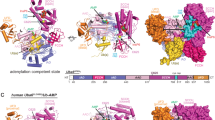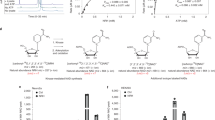Abstract
Vitamin K occurs in the natural world in several forms, including a plant form, phylloquinone (PK), and a bacterial form, menaquinones (MKs). In many species, including humans, PK is a minor constituent of hepatic vitamin K content, with most hepatic vitamin K content comprising long-chain MKs. Menaquinone-4 (MK-4) is ubiquitously present in extrahepatic tissues, with particularly high concentrations in the brain, kidney and pancreas of humans and rats1,2,3. It has consistently been shown that PK is endogenously converted to MK-4 (refs 4–8). This occurs either directly within certain tissues or by interconversion to menadione (K3), followed by prenylation to MK-4 (refs 9–12). No previous study has sought to identify the human enzyme responsible for MK-4 biosynthesis. Previously we provided evidence for the conversion of PK and K3 into MK-4 in mouse cerebra13. However, the molecular mechanisms for these conversion reactions are unclear. Here we identify a human MK-4 biosynthetic enzyme. We screened the human genome database for prenylation enzymes and found UbiA prenyltransferase containing 1 (UBIAD1), a human homologue of Escherichia coli prenyltransferase menA. We found that short interfering RNA against the UBIAD1 gene inhibited the conversion of deuterium-labelled vitamin K derivatives into deuterium-labelled-MK-4 (MK-4-d7) in human cells. We confirmed that the UBIAD1 gene encodes an MK-4 biosynthetic enzyme through its expression and conversion of deuterium-labelled vitamin K derivatives into MK-4-d7 in insect cells infected with UBIAD1 baculovirus. Converted MK-4-d7 was chemically identified by 2H-NMR analysis. MK-4 biosynthesis by UBIAD1 was not affected by the vitamin K antagonist warfarin. UBIAD1 was localized in endoplasmic reticulum and ubiquitously expressed in several tissues of mice. Our results show that UBIAD1 is a human MK-4 biosynthetic enzyme; this identification will permit more effective decisions to be made about vitamin K intake and bone health.
This is a preview of subscription content, access via your institution
Access options
Subscribe to this journal
Receive 51 print issues and online access
$199.00 per year
only $3.90 per issue
Buy this article
- Purchase on Springer Link
- Instant access to full article PDF
Prices may be subject to local taxes which are calculated during checkout




Similar content being viewed by others
References
Shearer, M. J., McCarthy, P. T., Crampton, O. E. & Mattock, M. B. in Current Advances in Vitamin K Research (ed. Suttie, J. W.) 437–452 (Elsevier, 1988)
Thijssen, H. H. W. & Drittij-Reijnders, M. J. Vitamin K distribution in rat tissues: dietary phylloquinone is a source of tissue menaquinone-4. Br. J. Nutr. 72, 415–425 (1994)
Thijssen, H. H. W. & Drittij-Reijnders, M. J. Vitamin K status in human tissues: tissue-specific accumulation of phylloquinone and menaquinone-4. Br. J. Nutr. 75, 121–127 (1996)
Martius, C. & Esser, H. O. Über die Konstitution des im Tierkörper aus Methylnaphthochinon gebildeten K-Vitamines. Biochem. Z. 331, 1–9 (1958)
Billeter, M. & Martius, C. Über die umwandlung von phyllochinon (vitamin K1) in vitamin K2 (20) in tierkörper. Biochem. Z. 333, 430–439 (1960)
Martius, C. The metabolic relationships between the different K vitamins and the synthesis of the ubiquinones. Am. J. Clin. Nutr. 9, 97–103 (1961)
Guillaumont, M. et al. Hepatic concentration of vitamin K active compounds after application of phylloquinone to chickens on a vitamin K deficient or adequate diet. Int. J. Vitam. Nutr. Res. 62, 15–20 (1992)
Thijssen, H. H. W., Drittij-Reijnders, M. J. & Fischer, M. A. J. G. Phylloquinone and menaquinone-4 distribution in rats: synthesis rather than uptake determines menaquinone-4 organ concentrations. J. Nutr. 126, 537–543 (1996)
Shearer, M. J. & Newman, P. Metabolism and cell biology of vitamin K. Thromb. Haemost. 100, 530–547 (2008)
Dialameh, G. H., Yekundi, K. G. & Olson, R. E. Enzymatic alkylation of menaquinone-0 to menaquinones by microsomes from chick liver. Biochim. Biophys. Acta 223, 332–338 (1970)
Ronden, J. E., Drittij-Reijnders, M. J., Vermeer, C. & Thijssen, H. H. Intestinal flora is not an intermediate in the phylloquinone–menaquinone-4 conversion in the rat. Biochim. Biophys. Acta 1379, 69–75 (1998)
Davidson, R. T., Foley, A. L., Engelke, J. A. & Suttie, J. W. Conversion of dietary phylloquinone to tissue menaquinone-4 in rats is not dependent on gut bacteria. J. Nutr. 128, 220–223 (1998)
Okano, T. et al. Conversion of phylloquinone (vitamin K1) into menaquinone-4 (vitamin K2) in mice: two possible routes for menaquinone-4 accumulation in cerebra of mice. J. Biol. Chem. 283, 11270–11279 (2008)
Suttie, J. W. in Present Knowledge in Nutrition 7th edn (eds Ziegler, E. E. & Filer, L. J. Jr) 137–145 (ILSI Press, 1996)
Tabb, M. M. et al. Vitamin K2 regulation of bone homeostasis is mediated by the steroid and xenobiotic receptor SXR. J. Biol. Chem. 278, 43919–43927 (2003)
Ichikawa, T., Horie-Inoue, K., Ikeda, K., Blumberg, B. & Inoue, S. Steroid and xenobiotic receptor SXR mediates vitamin K2-activated transcription of extracellular matrix-related genes and collagen accumulation in osteoblastic cells. J. Biol. Chem. 281, 16927–16934 (2006)
Igarashi, M. et al. Vitamin K induces osteoblast differentiation through pregnane X receptor-mediated transcriptional control of the Msx2 gene. Mol. Cell. Biol. 27, 7947–7954 (2007)
Booth, S. L. & Suttie, J. W. Dietary intake and adequacy of vitamin K. J. Nutr. 128, 785–788 (1998)
Thijssen, H. H., Vervoort, L. M., Schurgers, L. J. & Shearer, M. J. Menadione is a metabolite of oral vitamin K. Br. J. Nutr. 95, 260–266 (2006)
Wallace, B. J. & Young, I. G. Role of quinones in electron transport to oxygen and nitrate in Escherichia coli. Studies with a ubiA− menA− double quinone mutant. Biochim. Biophys. Acta 461, 84–100 (1977)
Lin, E. C. C. & Kuritzkes, D. in Escherichia coli and Salmonella typhimurium: Cellular and Molecular Biology (eds Neidhardt, F. C. et al.) 202–221 (American Society for Microbiology, 1987)
Meganathan, R. in Escherichia coli and Salmonella: Cellular and Molecular Biology 2nd edn (eds Neidhardt, F. C. et al.) 642–656 (American Society for Microbiology, 1996)
Suvarna, K., Stevenson, D., Meganathan, R. & Hudspeth, M. E. S. Menaquinone (vitamin K2) biosynthesis: localization and characterization of the menA gene from Escherichia coli. J. Bacteriol. 180, 2782–2787 (1998)
López-Martín, J. M. et al. Missense mutation of the COQ2 gene causes defects of bioenergetics and de novo pyrimidine synthesis. Hum. Mol. Genet. 16, 1091–1097 (2007)
Suhara, Y., Wada, A. & Okano, T. Elucidation of the mechanism producing menaquinone-4 in osteoblastic cells. Bioorg. Med. Chem. Lett. 19, 1054–1057 (2009)
Taggart, W. V. & Matschiner, J. T. Metabolism of menadione-6,7-3H in the rat. Biochemistry 8, 1141–1146 (1969)
Spronk, H. M. et al. Tissue-specific utilization of menaquinone-4 results in the prevention of arterial calcification in warfarin-treated rats. J. Vasc. Res. 40, 531–537 (2003)
Orr, A. et al. Mutations in the UBIAD1 gene, encoding a potential prenyltransferase, are causal for Schnyder crystalline corneal dystrophy. PLoS ONE 2, e685 (2007)
Weiss, J. S. et al. Mutations in the UBIAD1 gene on chromosome short arm 1, region 36, cause Schnyder crystalline corneal dystrophy. Invest. Ophthalmol. Vis. Sci. 48, 5007–5012 (2007)
Weiss, J. S. et al. Genetic analysis of 14 families with Schnyder crystalline corneal dystrophy reveals clues to UBIAD1 protein function. Am. J. Med. Genet. A 146, 271–283 (2008)
Acknowledgements
We thank M. Sugiura and A. Takeuchi for technical support with 2H-NMR analysis and LC-APCI-MS/MS analysis. This work was supported in part by priority areas from the Ministry of Education, Culture, Sports, Science and Technology (to K.N. and T.O.).
Author information
Authors and Affiliations
Contributions
K.N. and T.O. planned the project and analysed the experiments, together with Y.H., N.S., N.Y., M.W., Y.U., N.O., Y.S. and Y.S. The manuscript was written by K.N. and T.O., and all authors commented on it.
Corresponding author
Ethics declarations
Competing interests
The authors declare no competing financial interests.
Supplementary information
Supplementary Figures
This file contains Supplementary Figures 1-8 with legends. (PDF 230 kb)
Rights and permissions
About this article
Cite this article
Nakagawa, K., Hirota, Y., Sawada, N. et al. Identification of UBIAD1 as a novel human menaquinone-4 biosynthetic enzyme. Nature 468, 117–121 (2010). https://doi.org/10.1038/nature09464
Received:
Accepted:
Published:
Issue Date:
DOI: https://doi.org/10.1038/nature09464
This article is cited by
-
Revisiting the interconnection between lipids and vitamin K metabolism: insights from recent research and potential therapeutic implications: a review
Nutrition & Metabolism (2024)
-
Structural analysis of phosphoribosyltransferase-mediated cell wall precursor synthesis in Mycobacterium tuberculosis
Nature Microbiology (2024)
-
Different vitamin K forms in hemodialysis patients: a simple dietary supplement to battle vascular calcification—randomized controlled trial
The Egyptian Journal of Internal Medicine (2023)
-
Diverse biological functions of vitamin K: from coagulation to ferroptosis
Nature Metabolism (2023)
-
Vitamins as regulators of calcium-containing kidney stones — new perspectives on the role of the gut microbiome
Nature Reviews Urology (2023)
Comments
By submitting a comment you agree to abide by our Terms and Community Guidelines. If you find something abusive or that does not comply with our terms or guidelines please flag it as inappropriate.



